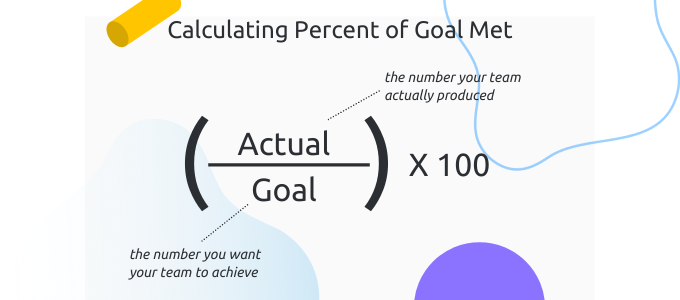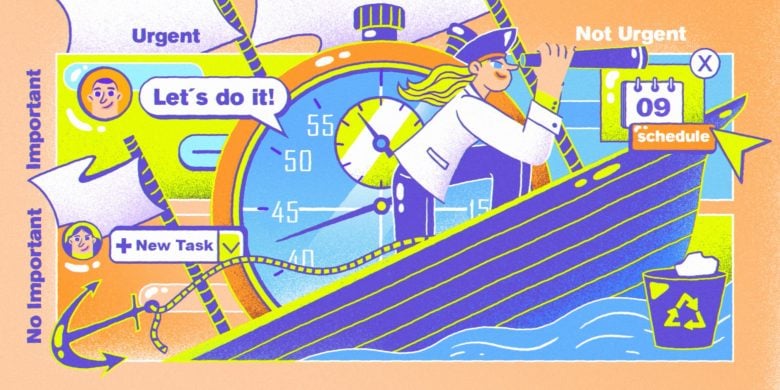How do I get my employees to be more productive without micromanaging or constantly offering incentives? Why do some teams seem to get things done effortlessly while mine struggles to meet deadlines?
These are just two of the many questions we ask ourselves about how to encourage teams to do good work.
It’s frustrating when your team is always behind. No matter what you do, you never seem to catch up. You know your employees are capable of being more productive, but you don’t know what strategies and employee productivity tracking software will help them get there.
We’re here to help.
In this guide, you’ll find proven strategies to help you prioritize, measure, and improve employee productivity.
Read straight through or use the links below to jump to the sections you need most.
- Defining employee productivity
- Factors that impact productivity
- How (and why) to measure your team’s productivity
- Strategies to improve employee productivity
- Set expectations
- Identify and stop micromanagement
- How to hire for your culture
- Onboard the right way
- Develop your team’s skills
- Recognize and reward achievements
- Improve team communication
- Provide valuable feedback
- Have more effective meetings
- Try flexible scheduling
- Equip your team with the right tools
- Make time for focused work
- Take care of your employees’ health
- Fix workflow issues
- Build transparency and unity
- Next steps
Boost your team’s efficiency with Hubstaff's productivity tools
What is employee productivity?
Employee productivity means that your team is effective and efficient. They use their work hours wisely to produce more and better results in less time.
Being productive is about more than “getting stuff done.” A person who tweets random content on your business page is technically doing something, but they’re not exactly being productive, right?
You always hear the phrase “work smarter, not harder,” but how do you actually DO that?
In order to be productive, your team needs to meet three criteria:
- They get through their work and finish a reasonable quantity of tasks. This means they’re meeting deadlines and not spending too much time on any one thing.
- They do good quality work. The finished results meet or exceed your expectations.
- They don’t waste time on things that are lower priorities. Instead, they use time and effort efficiently.
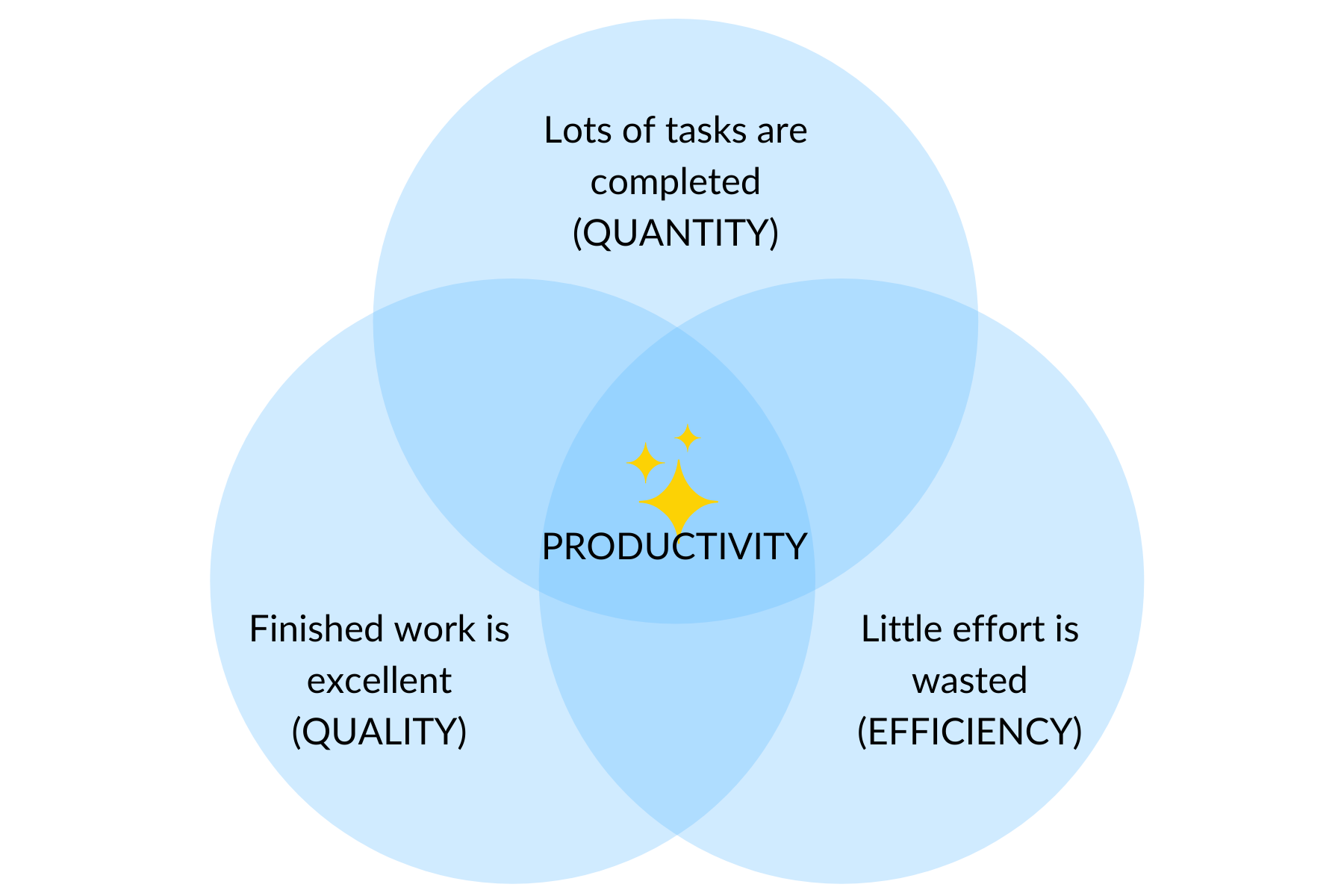
In other words, workforce productivity is about focusing on the right things at the right times. There’s very little time spent, and the work they do creates the results you want.
That’s why it can be so difficult to turn around a team that’s struggling to be productive. People are working, probably more than 40 hours a week, and they think you’re telling them to work even harder.
But the common advice “work smarter, not harder” doesn’t help in this situation. That leaves you with an important question. How do you work smarter? You can power through hundreds of tasks every day, but if they’re the wrong tasks, you’re still not productive.
Wondering how Hubstaff can help you increase productivity in the workplace?
Teams work better with Hubstaff. Chat with our specialists now and find out how.
To improve productivity in the workplace, you need to understand what’s going on in your team and address those specific challenges.
What factors affect employee productivity?
Dealing with employee productivity issues is often complicated. The problem has more than one source. Some of these factors will be outside of your control — like a global pandemic.
Still, there are plenty of things you can do to help your team be more productive. Focus on the things you can influence and worry less about all the stuff you can’t fix.
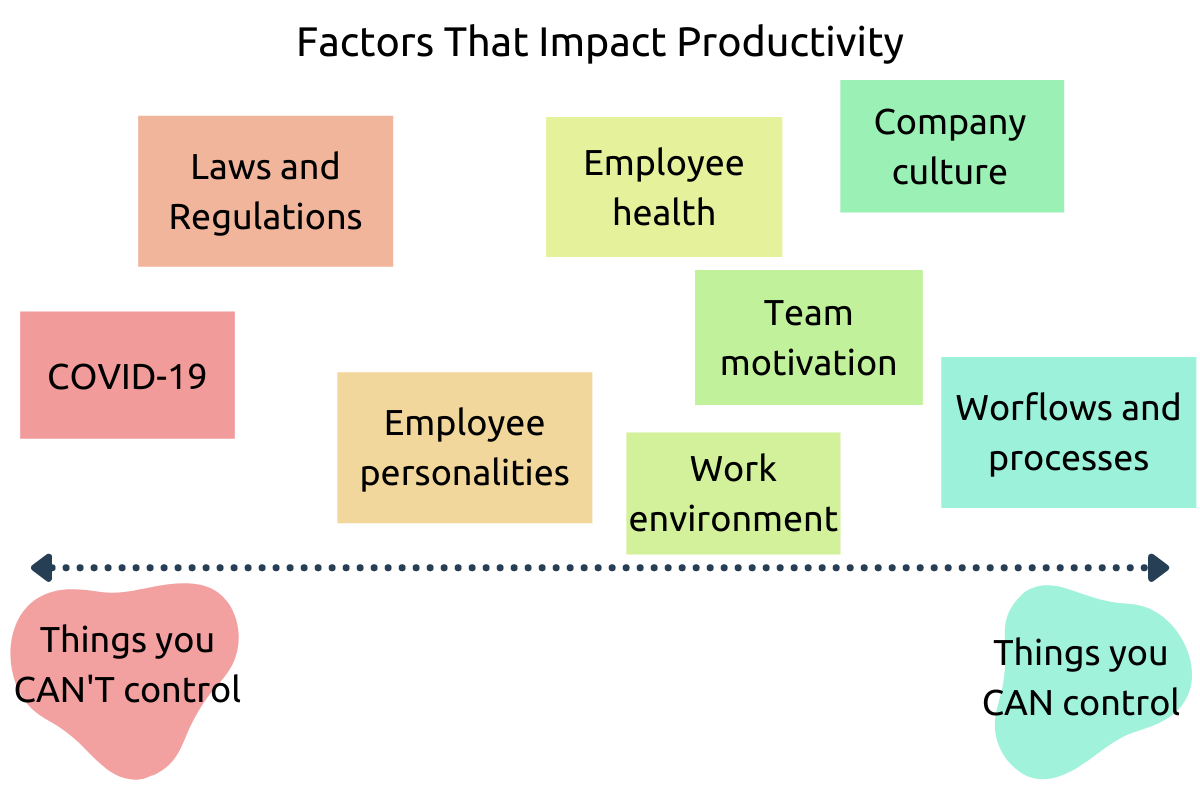
For example, it pays to invest in your team’s well-being. Encourage your team to stay physically and mentally healthy. Actively work on your company culture. These things show your team that you care and can help you maximize productivity in the workplace.
The way your team operates is important, too. Things like your work environment, communication habits, and workflows all make a big difference.
Before you can create an effective strategy, you need to know what factors are currently hurting your employee productivity. Here are some things to look out for:
Physical and mental health
Even before the pandemic, 61% of teams reported that they’re burned out at their current job. 31% feel high levels of stress at work.
Stress is terrible for employee productivity. Think about it. When you feel frazzled, don’t you find it hard to do great work?

Stressed out people are more likely to make mistakes. They’re also more likely to get sick because stress suppresses the immune system. The more stressful your work environment, the more often your people take sick days.
Even worse than taking frequent sick days is when people come to work ill. This is known as presenteeism – employees are present at work but not productive. Sick teammates perform poorly and are likely to pass their germs around, making the problem worse.
Even BEFORE the pandemic, 61% of teams reported that they felt burnt out at their current job.
This is why so many modern companies offer teams wellness programs. Studies show that these wellness initiatives can increase productivity in the workplace by up to 11%.
You don’t need a huge budget to launch a program of your own.
Good programs give an employee the resources and freedom to meet their personal health goals.
If you offer a wellness program, you have to be the top participant. Set the example. Prove to your team that this stuff matters.
Try some of these ideas to make room for wellness at your company:
- Encouraging employees to take a 20-minute break each morning for a walk, a quick workout, or some simple stretching exercises
- Set a company wellness goal. If your team uses fitness trackers, set a group goal to walk a certain number of total steps. If you meet the team goal, you can celebrate by going to get a healthy lunch together
- See if your team health plan provider offers any wellness support programs
- Get your team together to participate in a marathon or obstacle course race
- Start a weekly fitness class, either virtual or in your office
- Promote a healthy work-life balance by setting clear communication rules. If people are used to answering messages or sending emails after hours, put a stop to it
- Give your team permission to take mental health days. They’re not going to be productive when they’re overwhelmed anyway
Whatever you decide to do, make sure that you participate.
You can’t force teams to take care of themselves. But you can set the right example. Stop hopping on Slack after hours. Talk about the meaningful things you do outside of work. If you set a wellness challenge, be the one to beat.
At Hubstaff, we use our Communication Manifesto to help us set healthy limits. Nobody should be available at all times, and we encourage employees to turn off notifications when they step away from work. Personal time is not negotiable.
To set up your own Communication Manifesto, download ours as a useful starting point.
Skills and knowledge
Obviously, it’s important to have the right technical skills. An experienced, competent employee finishes work much more efficiently than someone who’s still learning the job.
Soft skills matter, too. Someone with great organizational skills and a strong sense of responsibility to their team is more likely to be productive.
You might be tempted to blame your team’s lack of knowledge or skills for your employee productivity issues. Be careful. Having the right skills is just a small part of the picture. If there are other roadblocks, even your most experienced employees will struggle to work efficiently.
Addressing information gaps is an ongoing process.
Think about the way knowledge is stored and shared at your company.
- Is it easy to find information about processes and procedures?
- Can teams access historical data to make informed decisions?
- Do all decisions need to go through you?
To be productive, an employee must be knowledgeable and have access to information.
Addressing knowledge gaps is an ongoing process.
Keeping information organized takes continuous effort. At the same time, your team needs to keep up with changes in your industry. Build good habits and your knowledge base will improve over time.
Workflows and processes
Inefficient workflows are a major drain. Your team can spend more time figuring out how to do their job than they actually spend doing the job.

This is a common problem. Studies show that 39% of people feel that the document management processes at their company are broken, with the biggest issue being actually locating documents. Another 55% of newly hired people say that they don’t get access to the tools and documents they need during onboarding.
Communication issues like these are expensive. Businesses lose $26,041 per knowledge worker every year due to communication barriers.
Spot workflow issues and save thousands of dollars
Hubstaff creates more visibility so you can spot and fix issues early.
The most productive companies write things down. Someone on your team should never have to ask you how to do a job — but if you are the only person who knows how things are supposed to be done, then everyone has to come to you for answers.
Don’t become your company’s biggest bottleneck.
39% of teams feel that their company’s document management process is broken.
Define roles, write down processes, and keep your workflow documents up to date. You’ll be able to spot inefficiencies in the way you handle projects, and you’ll make it easier for your team to do their jobs independently.
The Hubstaff team uses Hubstaff Tasks for this. We automate our workflows and use comments, checklists, and attachments to keep all the relevant information available to anyone who needs to work on a project. Because we work from our project management software, it’s easy to hand off work and jump in to help whenever needed.
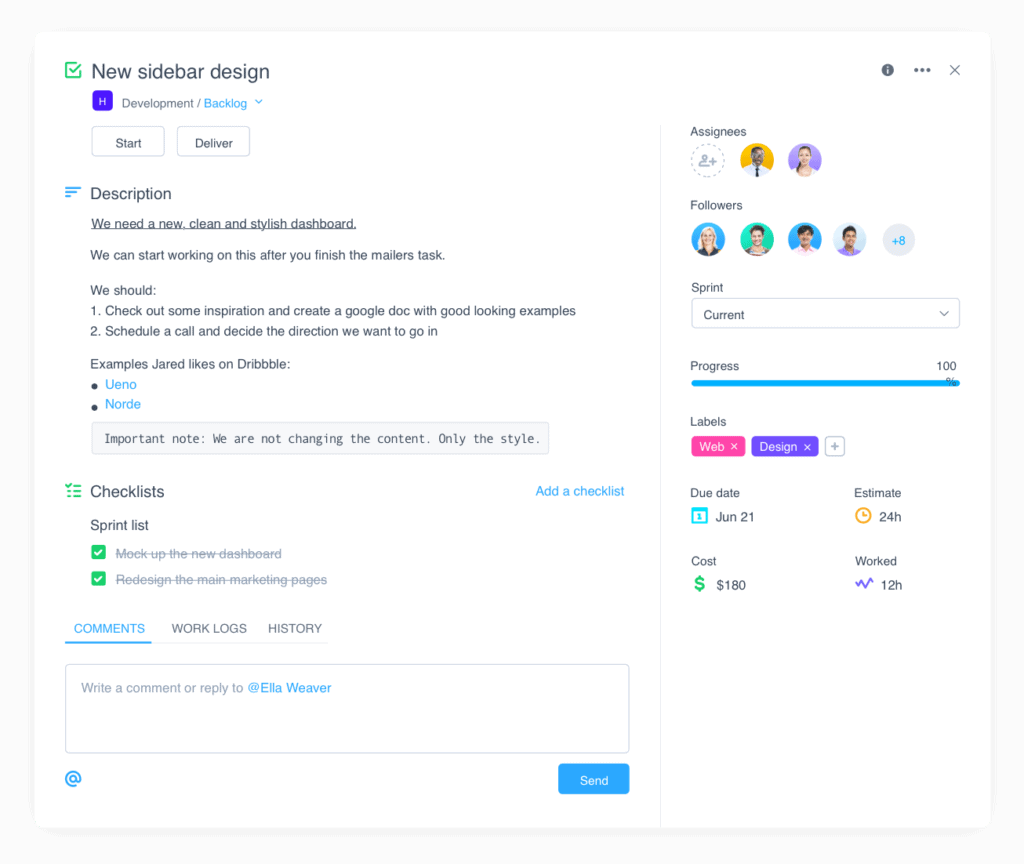
Work environment
During the pandemic, lots of companies saw firsthand how your environment affects employee output.
For some people, working from home was a great way to boost productivity. They found that they could focus better and get more done because they had more control over their environment. Workplace conditions were more comfortable, and it was easier to limit interruptions.
Others found it much harder to adjust to their new environment. Household distractions made it hard to focus. Many were unable to create a dedicated space for work.

You can learn from this. Your team’s workspace can either help them be more productive or make it harder to get work done.
You might have limited control over your team’s working environments, especially if they work remotely. However, that doesn’t mean you’re powerless. A few tweaks can go a long way.
Furniture
We spend 8 hours a day at our desks, so it’s important that they’re comfortable and healthy. If you can, it’s wise to equip your team with ergonomic office furniture.
Even in a well-designed chair, prolonged sitting is associated with some serious health risks. Fortunately, standing desks are proven to increase employee productivity in the workplace, too.
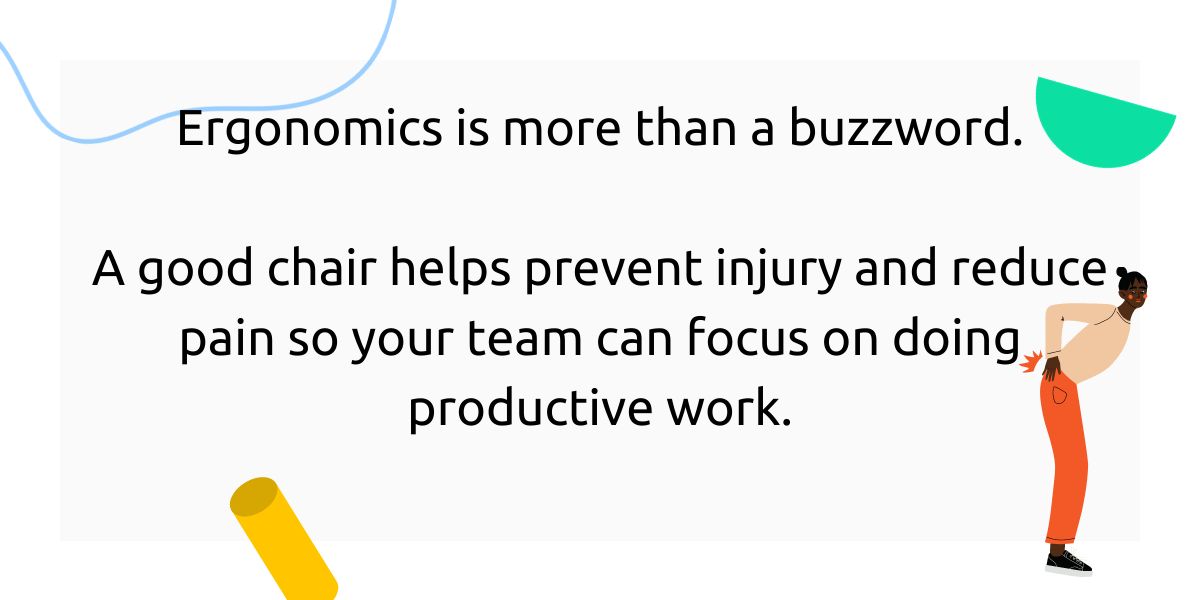
Similarly, providing each person with an ergonomic keyboard and mouse reduces the chances of one of the most common workplace injuries — carpal tunnel syndrome.
Lighting
Natural lighting reduces eye strain and headaches. It’s also a major mood booster, which may be why natural light is linked to increasing productivity in the workplace.
Put the people with the most computer-based work at seats that face windows. They’ll get the most benefit, and you’ll get the biggest workforce productivity boost.
Natural lighting reduces eye strain, helps boost mood, and is linked with better productivity. Open up those blinds and let in some sun!
This might now always be possible. Some offices just don’t have enough windows to ensure everyone gets some sunlight. In those cases, consider getting some daylight lamps to imitate natural light in the office.
Company goals
Here’s an experiment you can do right now:
Pick three people at random from different departments. Send them each an email or Slack with this message:
Hey, [name], I’m working on my communication strategy and I’d like to see how well I’ve done so far. Could you tell me in your own words what you consider our main goal as a company?
Do you think you’ll get the same answer from all three people?
When you write down goals and share them publicly with others, you’re more likely to achieve them. Give your team the chance to work together to achieve something awesome.
If your company’s goals are unclear, your team has nothing to focus on. Instead of working towards a bigger picture, they’re just finishing tasks and checking items off their list.
It’s hard to stay motivated when you feel like you’re just doing busywork.
You face a different challenge if your company goals are so far out of reach, it doesn’t even feel worth trying. Striving towards an impossible goal isn’t a recipe for success. It’s a straight road to burnout and frustration.
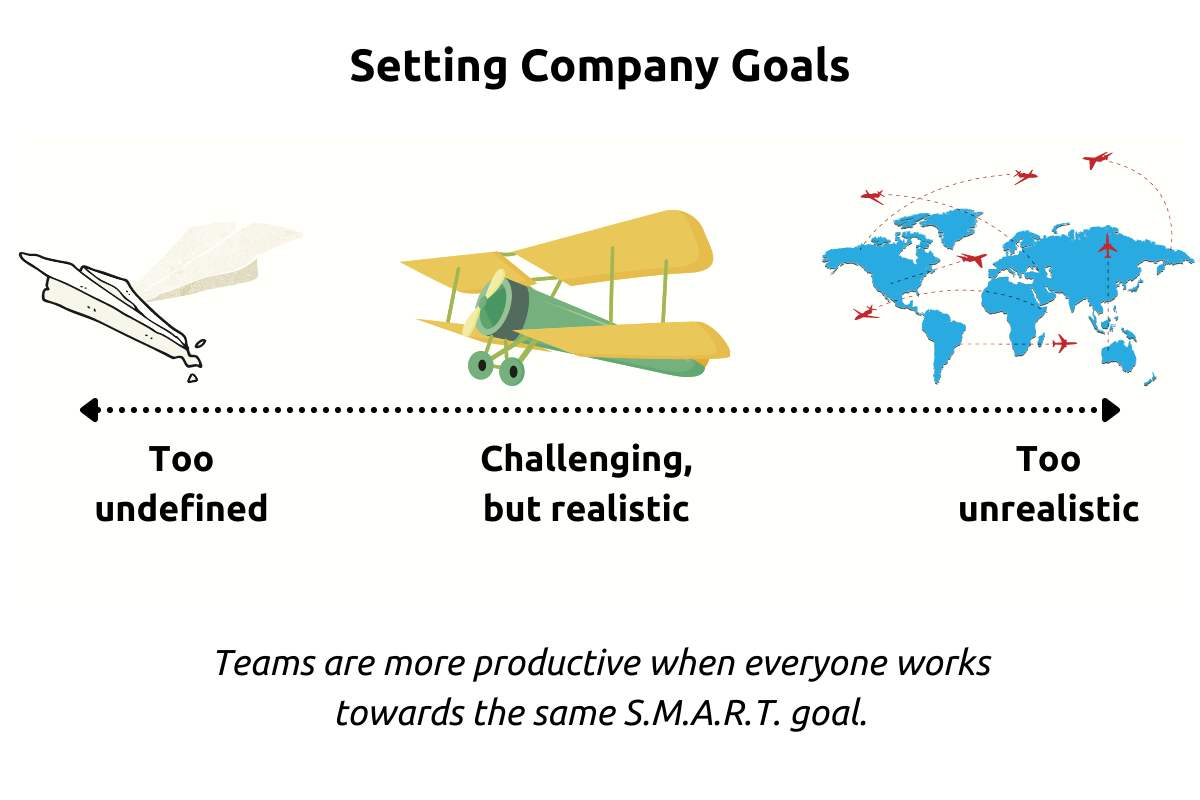
The goals you set for your company should be:
- Specific
- Measurable
- Achievable
- Relevant
- Time-bound
These are known as S.M.A.R.T. goals.
Studies also show that specific and challenging goals lead to higher performance compared to non-specific ones like “do your best.”
It’s important that company goals are aligned with people’s individual goals as well. When setting company goals, consider how these align with your team’s personal and professional plans.
How to measure employee productivity?

The best way to measure productivity for your company depends on your industry, workplace conditions, company size, and the types of products or services you sell. Most companies measure employee productivity based on:
- Percentage of goal met – One way of determining productivity is to set a goal for each team or department. This might be a number of sales a team needs to drive or an amount of revenue they need to generate. The goal should be specific and measurable.Then, calculate productivity based on what percentage of the goal the team or department has managed to reach in a specific period. The formula looks like this:
For example, imagine you have a bunch of new products for your online store, but you can’t list them until your team finishes photography, writes descriptions, and adds the new items to inventory. You can set a goal for your team to add 65 new products to the website this month. If they get 73 products on the site, they met 112% of the goal. If they only get 52 products added, they met 80% of the goal.
This measurement works well for goals with numeric values but doesn’t give you any indicator of quality. - Number of tasks completed – You can also measure productivity by looking at how many tasks an employee or team has managed to complete in a specific period. This method works best for repetitive, production-based jobs. For example, you might track the number of support tickets closed. For jobs with more variation in day-to-day tasks, this metric can be misleading. A developer might have a task to fix a display issue and a task to build and test a new type of contact form on your website. The time and effort required are drastically different, so simply completing the task is a poor measure of productivity.
- Revenue per employee – Some companies opt for looking at productivity as the amount of revenue they generate per employee. You can calculate your company’s revenue per employee by dividing the total revenue by the total number of employees.
- This measurement tells you about the overall productivity of your team instead of showing you how effective an individual employee is. As you work to improve productivity for your entire company, this is an informative number.
- Labor productivity formula – According to the labor productivity formula, productivity equals total output divided by total input. For example, let’s say your business generates $100,000 in revenue in a month with the help of 1,500 work hours. In that case, your productivity would be $100,000 / 1,500 hours worked = $66 per hour.
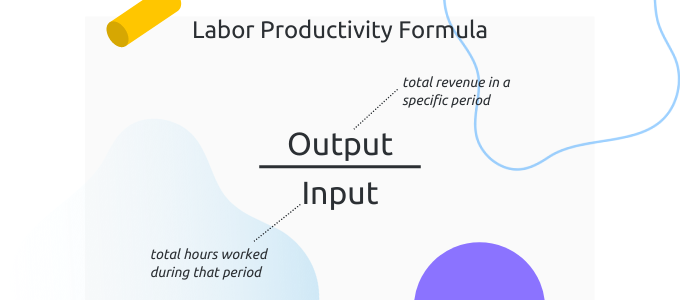
- Activity level – If your team works remotely, tracking activity level is a smart way to spot issues in real-time. Hubstaff users can see this information in the dashboard. Note that you should treat activity levels as an indicator, not a specific measure of productivity. Use historic data to help you understand how your team works on a regular basis. Changes to individual or group activity levels can tell you that it’s time to check in.
What, Why, and How to Measure Remote Employee Productivity
A Guide to Employee Productivity Metrics You Can Actually Use
The importance of measuring productivity
If you can’t measure it, you can’t improve it.
This applies to productivity as much as any of your other business metrics. Improving employee productivity allows you to do all of these things:
Improve profit margins
Productive teams make money for their companies. This is the whole point of measuring and improving your team’s productivity, right?
Tracking results gives you valuable insights that show you how to make more money.
For example, maybe you discover that your people get more work done when they work from home. Working remotely lowers your overhead costs, too. Inspired by this, you might make flexible schedules more available and allow teams to work at their own pace.
Productive employees make more money for their companies.
Identify your most valuable employees
Everyone on your team is good at what they do — that’s why you hired them. Still, some seem to consistently accomplish more.
They might be better at organizing their time or prioritizing work. Maybe they don’t mind coming in early or leaving late on those few occasions when there’s an important deadline.
Sometimes, it’s hard to notice all the efforts an employee takes to provide more value to your business. This is where it helps to measure employee productivity on an individual level.
Uncover workflow issues
An effective workflow helps you complete more tasks while using as little time and resources as possible.
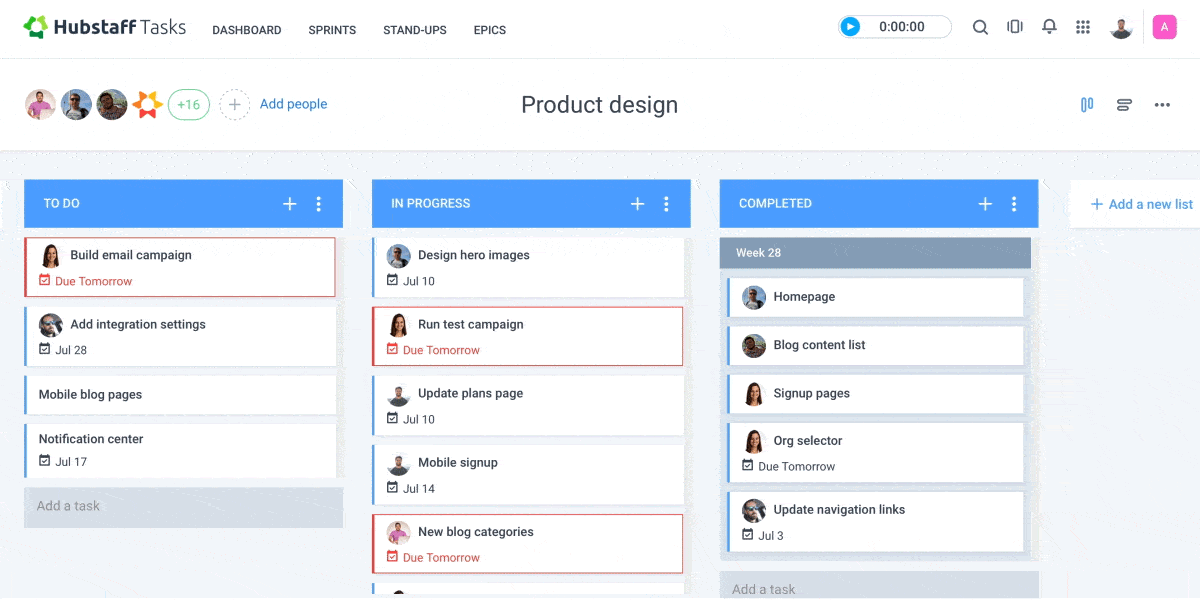
However, your workflows might have bottlenecks or other issues that make it harder to stay on track. Workflow issues range from unclear guidelines and lack of information to poor team organization and workload imbalances.
These problems aren’t as visible as you’d expect. Work gets backed up like traffic behind an accident. The difference is that a problem in the middle of the workflow can cause issues at the beginning, middle, and end. Until you look at the entire process, you just see the general backup.
Teams are more productive with Hubstaff
Assign tasks, track time, see productivity benchmarks, and pay international teams — it’s all possible with Hubstaff.
Ways to improve employee productivity
We’ve talked about the variety of things that affect productivity, from your company goals to your team’s mental health. We also explored some of the reasons why tracking is so important.
Now it’s time to break it down and look at specific ways to increase employee productivity.
Once you’ve identified the sources of your productivity problems, use these strategies to improve.
1. Set clear expectations
Your team only knows what you expect from them if you tell them.
Do you want your team to do things like this?
- Update all tasks in your project management software with their current status before the end of the week
- Respond to emails and messages within the same day, even if the response is “I got your message and I’ll look into this on Wednesday”
- Proofread all marketing materials before turning them in for approval
You need to tell them clearly that it’s important. It’s not as obvious as you think.
Maybe you think it’s ridiculous that you need to tell someone to double-check their work for typos, but they might think that the whole reason they submit for approval is because it’s your job to catch those errors.
You need to be clear about what’s important to you. Most of the time, it’s not as obvious as you think.
If you don’t make your expectations clear, there’s anger and resentment on both sides. You want things that you’re not getting. Your team feels like you’re demanding and unfair.
As you work on communicating your expectations, it’s okay to challenge people. As long as you’re realistic, you can ask for a little more.
Strike the right balance between what your team delivers now and what you know they’re capable of doing. Look at each person’s past performance data. This can give you an idea of their limits.
It’s unwise to ask for a drastic increase in results, even if you know they can get there with more effort. Expectations that look too difficult will actually hurt performance. Your team feels that since they have no chance of reaching that goal, they might as well not try at all.
Use S.M.A.R.T. goals to set specific benchmarks in areas like these:
Job-specific performance
Performance goals are some of the most important when you’re working on workforce productivity. These expectations should be directly linked to your larger business goals.
When setting performance expectations, make sure that it’s something your employee can directly influence or control.
For example, let’s say you want to reduce the number of returns your customers make. Your job-specific expectations might look like this:
- For customer support, the average satisfaction rating for each agent should be at least 3.6 stars
- For your shipping department, overall order errors should be below 0.25%
- For development, any website-related bugs assigned to a developer should be fixed within five business days
Goals may be individual or might apply to a specific team. Of course, you can evaluate multiple metrics to give you a more complete picture of job performance.
Be careful to choose a measurement that your employee can directly influence. It’s frustrating for everyone if you expect your marketing team to drive online sales, but they have no control over the layout and functionality of the website. It may be more realistic to expect your marketing team to drive a certain amount of qualified traffic.
It’s also important to let each employee know how often you’ll review their performance.
Some of your performance expectations may be tracked on an ongoing basis. Due dates are a good example. You’ll notice immediately if a task or project is past due.
Others can be measured at specific intervals. It makes sense to track website traffic each month. Higher-level metrics can be reviewed every quarter or once per year.
Communication
Have you ever hesitated to send someone a message because you knew they weren’t going to respond before you found the answer on your own? It’s frustrating when your team isn’t there when you need them.
Set some basic communication guidelines to help keep your team running smoothly. These expectations might include:
- Being respectful, honest, and straightforward when talking with co-workers
- Using the right communication channel for the situation (e.g., emails for lengthy discussions, Slack messages for quick updates, etc.)
- Responding to messages promptly
For example, you might tell your team that they can check emails once or twice a day, but that they should check direct Slack messages within a couple of hours.
You can also set limits on how public Slack channels are used to make sure you’re sharing information without interrupting everyone’s day. At Hubstaff, we expect our team to reply in comment threads instead of the general channel to keep conversations organized and prevent important updates from getting buried.
Team communication can make or break your productivity. For more help, get our free Communications Manifesto.
Meeting deadlines
You set deadlines for a reason. Due dates help you manage priorities and keep your team working as an organized unit.
When people miss deadlines, it affects everyone else in the workflow. You either need to adjust the entire timeline for the project, or the next person has to scramble to meet their own due dates because they got started later than they expected.
Stress the importance of meeting deadlines by showing your team where they fit in the workflow. They’ll be more conscious of priorities when they see how it impacts their teammates.
Due dates help you manage priorities and keep your team working together.
Keep in mind that your due date might look reasonable on its own, but your team has a lot of other things going on at the same time. If you assign a bunch of deadlines at the end of this week, some of them are going to be missed.
If this is a problem in your team, project management software can help a lot. Tools like Hubstaff Tasks can help you create realistic timelines and manage due dates, even when priorities change.
Assigning and meeting deadlines takes practice.
As you get used to this process, check in each time you assign a new task or change a deadline. They should look at the other things on their plate at the same time and either confirm that your goal is realistic or request that you shuffle some things to make room.
2. Don’t micromanage
Wanting to stay on top of everything that goes on in your business is natural. However, it shouldn’t involve constantly telling people how they should do their job.
Micromanagement happens because you’re trying so hard to get the results you want. In reality, you’re hurting employee morale and performance. This destroys employee productivity.
Plus, you can’t be effective at your own job when you spend so much time being involved in everyone else’s. This creates major bottlenecks and slows down everyone’s work.

Even if you hate the idea of micromanaging your team, you might still have some bad habits that you’re not conscious of at the moment.
You might be a micromanager if you:
- Don’t like delegating work – Are you reluctant to delegate because you think you can do a better job than an employee can? That’s micromanagement.
- Must proof and approve everything – Everyone makes mistakes. Your team will make them too. It’s fine to correct an employee’s mistake when you notice it, but it’s a much better approach to teach them to double-check their work so that you don’t have to correct them.
- Ask for minor changes on everything – When things come to you for approval, do you always have a suggestion for at least one nitpicky change? Sure, everything can be improved. But not everything needs to be improved.
- Make all the decisions and solve all the problems – Do all decisions need to come to you for a final stamp of approval? That’s frustrating for your team, and it’s a major productivity drain. Empower people to solve their own problems.
- Attend every meeting – It’s highly unlikely that you’re needed at every single meeting. Think about whether teams really need your input at a particular meeting before deciding to join it. Remember, you can always catch up on the highlights later.
- Ask each employee to CC you on every email – Are you that one employee who wants to be in on every discussion your team has? A lot of email chains are largely a waste of time. You should be spending your time on more important things anyway.
- Always ask for updates – While it’s fine to want to know the status of a particular project, constantly asking an employee for updates on every little thing makes them anxious and wastes time they could be spending actually working on the project.
- Focus on how tasks should be done instead of why they need to be done – This gets right to the point. A micromanager wants everything done their way. Good leaders don’t care about minor details as long as the goal is accomplished.
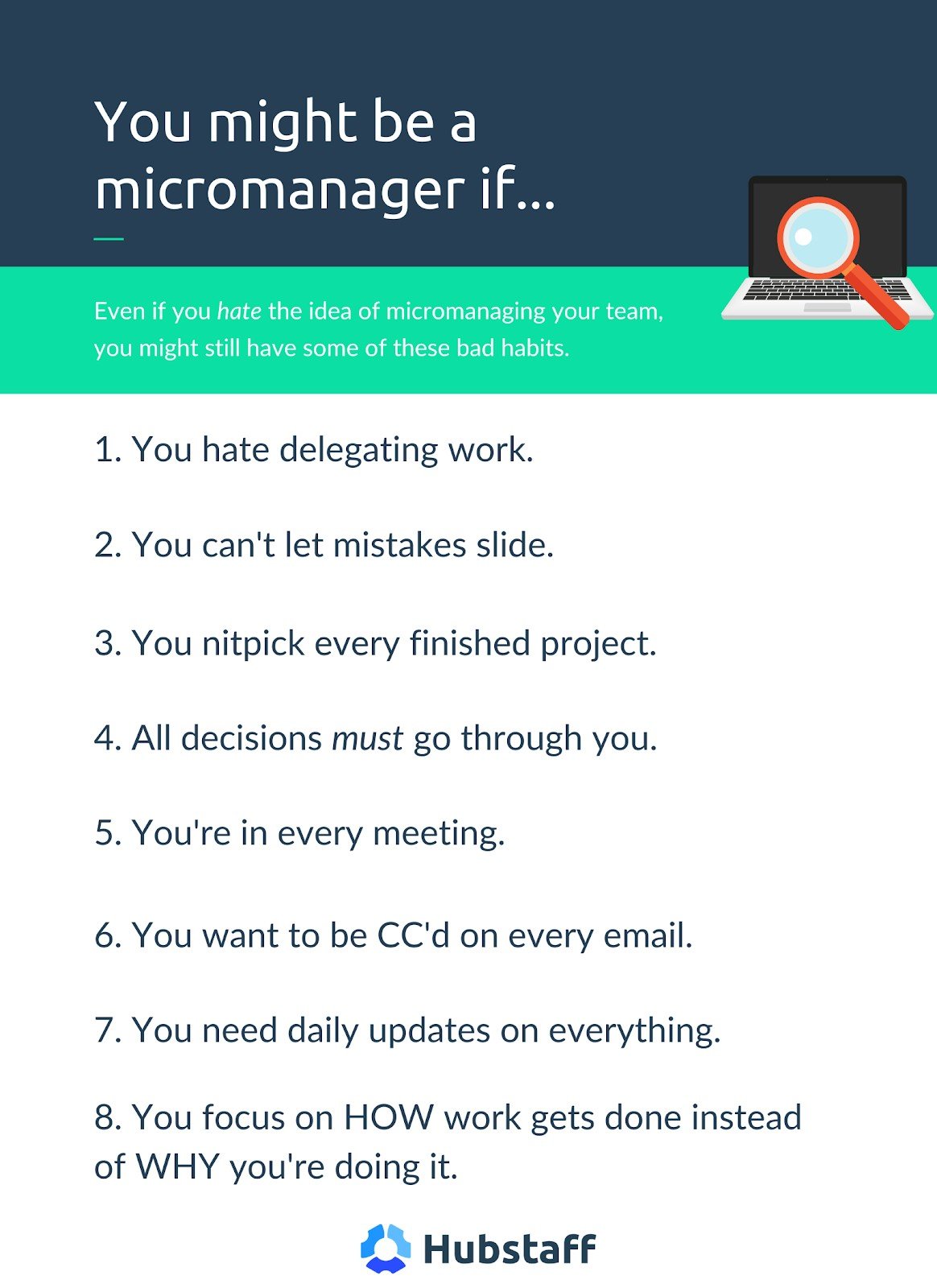
If you recognize some of your own habits on that list, here’s what to do.
Don’t be a perfectionist
It’s great to have high standards, but perfectionism is harmful to you and your team. Obsessing over perfection causes anxiety, depression, and frustration.
The problem is that perfection is impossible. You and your team will make mistakes, and that’s okay. Mistakes are learning experiences.
Be more willing to let your team make mistakes. Set realistic goals and expectations.
Mistakes are learning experiences. Learn to appreciate them.
Trust each employee to do their job
Micromanagers don’t believe that others can complete tasks as well as they can. One of the best ways to increase employee productivity is to simply trust people.
That toxic behavior destroys productivity and employee engagement. Nobody wants to work for someone who treats them like they’re incompetent.
Trusting your team to make decisions isn’t an all-or-nothing thing. You can set specific boundaries so you’re still involved where you need to be.
If you don’t trust your team, they don’t trust you, either. To fix it, you’ll need to prove again and again that you have faith in each and every employee.
Start by encouraging people to make decisions without your sign-off. You can set specific parameters to make it clear which choices must go through you and what teams are empowered to do on their own.
Focus on tasks that can’t be delegated
Aren’t you busy enough? Focus on completing tasks only you can handle. Delegate everything else to your team.
If you find it hard to figure out which tasks to delegate, you can use the Eisenhower Matrix. It divides tasks into four categories:
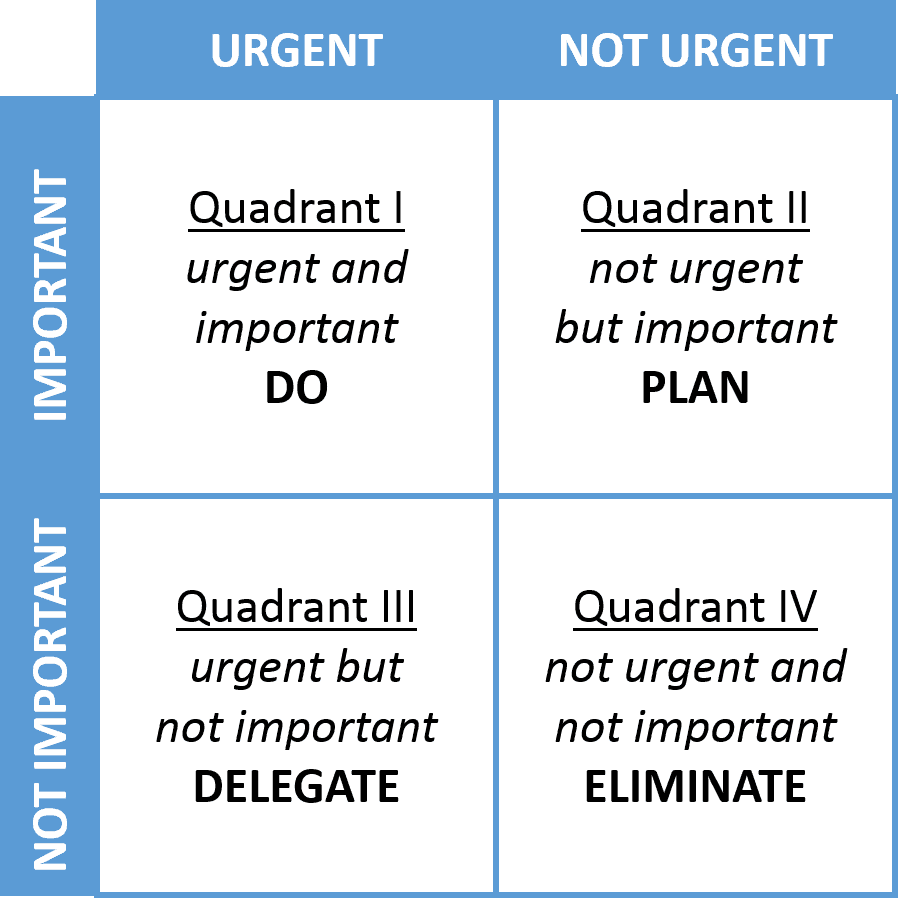
Delegate all tasks that are urgent but not really important, and focus on urgent and important tasks instead.
This matrix is a handy guide for people who have a hard time recognizing the tasks that only you can do.
Remember to focus on the reasons why a task is important instead of the specific way you want it to be done. If the finished work accomplishes the goal, it doesn’t matter whether it was done exactly how you would have done it.
Automation can be a major timesaver, too.
Instead of delegating simple tasks to a person, you can use tools to automate some of your work to free up human hours.
For example, you might decide to automate expense reporting.
The experts at Fyle HQ point out that it’s a huge time waster to manage expenses with emails, spreadsheets, and manual expense forms. Plus, it’s way too easy for a dishonest person to take advantage of a manual expense system.
We recommend using automation in situations like these. It’s way faster and easier to use a simple expense tracking system, especially if you deal with a lot of expense reporting. You can also build in safeties and rules that help prevent abuse.
Look for automation solutions that give you total visibility, but that you don’t need to spend a lot of time managing. You want to find a way to spend less time on tasks, not more.
3. Hire for cultural fit
A company’s culture includes the values and beliefs that each employee shares. Each employee you hire has a cultural impact on your company.
How well a person’s beliefs and values align with your company’s can significantly boost employee productivity. An employee who is a cultural fit for your company will have an easier time collaborating and communicating with others.
If a person doesn’t fit in with the rest of the team, on the other hand, they’ll be dissatisfied. They’ll also have a hard time collaborating with the rest of the team. As such, they’ll likely be less productive and drive employee productivity down.
You can be diverse and still have a unified culture. Build your culture around important values and goals and look for a fit there. At the same time, embrace different perspectives and backgrounds for a stronger, more diverse team.
Here’s how to make sure you hire people that align with your culture:
- Create a culture document – Start by creating a culture document that describes your company’s values. Make sure to also outline what kind of behavior you expect from each employee. We at Hubstaff have an Employee Handbook that everyone reads during the onboarding process.
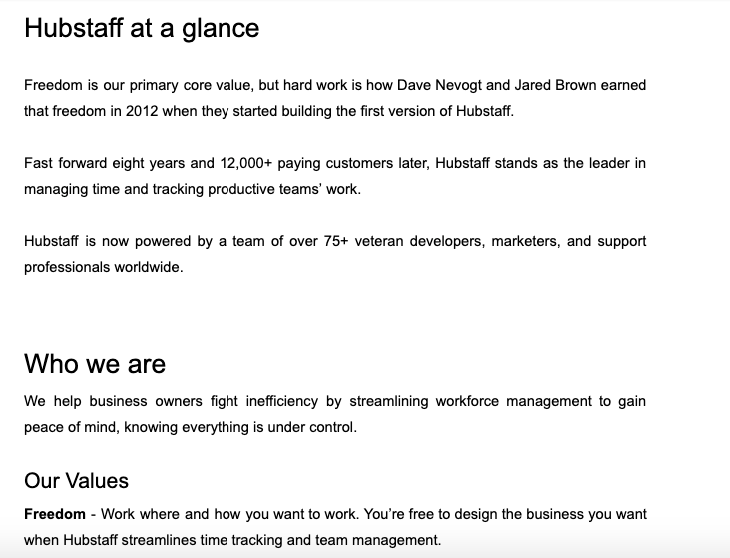
- Advertise your company values – 46% of job seekers consider company culture very important when evaluating potential employers. Accentuate your company values in your job descriptions. Also, provide potential applicants with a link to your culture document.
- Discuss company culture during the initial interview – Let candidates know what your company values are during the initial interview. Explain how you work as a team and let candidates ask questions.
- Try to gauge how candidates would fit in –
- Ask questions that will help you understand if candidates’ values align with your culture. Here are some questions you can use:
- What did you like most about your previous job?
- How would you describe our culture based on what you’ve seen and heard?
- Why do you want to work for our organization?
- What are your best and worst personality traits, and why?
- What values are most important to you as a person?
- What type of working environments do you thrive in?
- Prioritize cultural fit over “nice to have” skills – Skills can be taught. Cultural fit, on the other hand, can’t. When comparing candidates with similar skill sets, prioritize those that seem like a better cultural fit for your organization.
How to Build a Kick-Ass Remote Culture
How to Hire Remote Workers: A Quick Guide and a Free Contract
4. Improve your team member onboarding program
When you’re making a new hire, you’re excited. Your team is growing!
You go through a long and hard interview process and single out the right candidate. It’s not uncommon at this stage to worry about whether you made the right choice.
Even if you are certain you hired the right person, you might still worry about how much time you need to get them up to speed.
It would be great if this person could start working as efficiently as possible right away. That rarely happens, though. It takes time for a new hire to learn how you do things. They need to get to know their teammates, learn about the projects that are already in progress, and get used to the culture.
This can be frustrating. You hired a new person because you don’t have enough time to do everything yourself. Now, you find yourself spending even more time on their job.
You can outsource the hardware setup to an IT company like Ascendant Technologies to speed up the onboarding process.
You’d like them to learn faster, but there’s no real way to force this. What you can do, however, is provide them with the resources they need to get up to speed. This is where it’s crucial to have a good employee onboarding program.
Get the free Onboarding Checklist
Bring new team members up to speed faster with this helpful to do list.
Your onboarding program should teach new hires everything they need to know to be a productive member of your team. It should also help them fit in with the rest of the team faster.
Here’s how to adjust your onboarding program to get new hires up to speed more quickly:
- Start onboarding immediately – Your onboarding process should start as soon as your new hire accepts your offer. Schedule a call to go over your company’s documentation and policies.
- Share goals and expectations on the first day – Educate your new hire on key priorities during the first day. Let them know the team’s goals and key performance indicators (KPIs), as well as their own individual KPIs.
- Discuss career path – You should talk with your new employee about their potential career path early. Educate them on promotion criteria and what’s the potential next step on the ladder for them.
- Provide new hires with a mentor – 87% of companies who use buddy programs state that these programs improve the efficiency of new hires. Make sure you assign a mentor to each new hire. This person should help them with getting started. They should also be available to answer any questions the new hire might have.
5. Provide ongoing training
Hiring isn’t the only way to grow. Your existing teams should have plenty of opportunities to upgrade their skills and help your organization achieve more.
Your environment evolves over time. Think about what it meant to be a social media manager in 2010. It’s completely different than the same job today.
Ongoing training is a smart way to make sure your team is well equipped to keep up with a rapidly changing economy.
Hiring isn’t the only way to grow. Invest in your people to grow from within.
Training isn’t just for job specific-skills. Soft skills like organization and time management techniques are necessary for maximum productivity, and most people never receive real training in these important areas.
By improving their skills and knowledge, employees also become more confident, more effective, and more engaged.
Offering ongoing training shows your team that you care about their future. It’s a good strategy to build trust with your team while you work towards maximum productivity.
A lot of managers worry about the investment because there’s no guarantee that your employees will stick around after you’ve spent time and money helping them grow. The more skilled your people are, the more valuable they become. Some people will leave and seek a higher-paying position that you trained them for.
Yes, some of your people will leave after you’ve invested time and money in them. But what’s worse — investing in someone who leaves, or not investing in people who stay?
Here’s how to get started with creating a team member development plan:
Analyze team member skill gaps
Maximizing productivity is easier when there’s a good match between the skills your employees have and the skills that are necessary to operate your business.
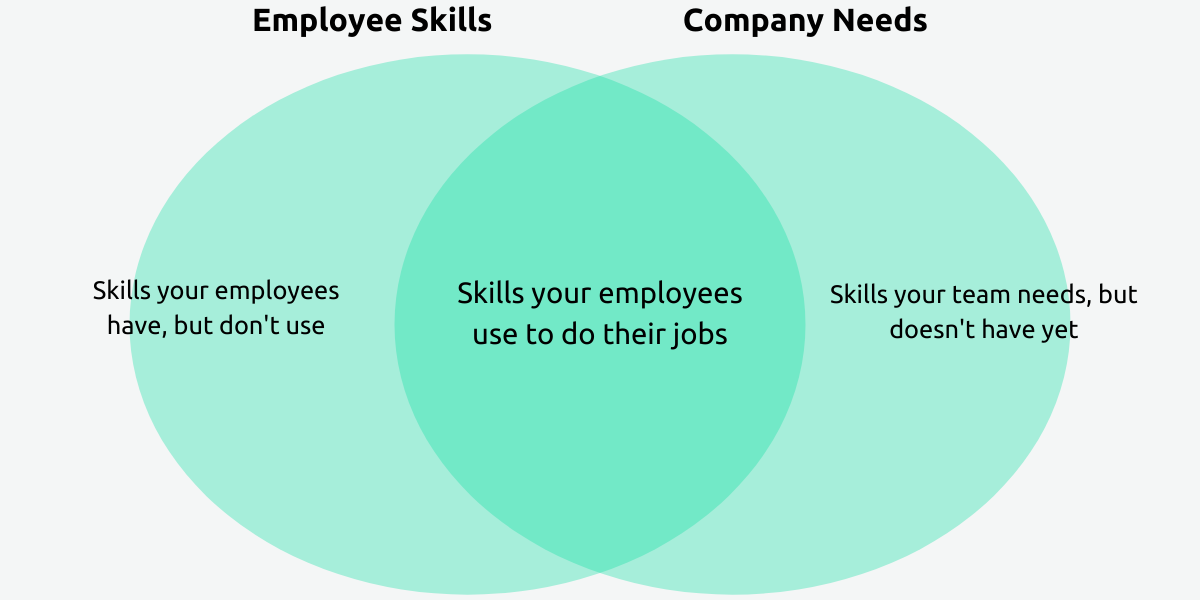
A skill gap analysis helps you identify the skills employees need to fulfill their job duties but currently lack.
You can perform a skill gap analysis on an individual or team level.
An individual skill gap analysis looks at the skills a particular job requires and then compares them to the skills an employee actually has. It’s useful for when an employee’s duties change or they do poorly on their most recent performance review.
Performing a company-wide skill gap analysis, on the other hand, is useful if your organization is having problems meeting business goals or if you’re planning a strategy shift that requires employees to develop new skills.
After deciding on the type of skill gap analysis you’ll perform, the next step is to identify crucial employee skills.
Think about which skills you value as an organization. Then, consider which skills your employees need to do their job well, as well as what kind of skills they might need in the future.
Finally, use surveys, assessments, employee interviews, and performance reviews to measure your employees’ current skill levels.
While you can perform a skill gap analysis internally, there are also consultants you can hire that specialize in this type of analysis. Hiring outside help can often make for more objective analysis, as well as free up your time spent on menial tasks.
Set measurable learning goals
Throughout this entire article, we’ve talked about setting clear, measurable goals. That still applies.
You have specific business goals in mind when you offer training. Your employees should have their own goals, too.
Determine exactly what you want to accomplish from your training program. This will help you choose the right training methods and materials.
Your goals also help employees to understand what’s expected of them and give them a better chance of meeting your expectations. Encourage team members to set their own personal goals before they get started.
For example, do you want to help encouraging employees to improve job-specific skills, develop the right attitude towards work, or increase their knowledge of the company’s industry? Are you grooming people for advancement as your team grows or helping them gather knowledge so they can make strategic decisions?
Your goals, whatever they may be, should be aligned with your business objectives. They should also be realistic and relatively easy to measure.
Here’s an example: I want to train employees to be able to complete routine tasks in 25% less time within the next six months.
Some companies make training mandatory, but most allow employees to participate voluntarily. However you do it, make sure that your team is incentivized to participate.
There’s no point in creating a voluntary training program if nobody takes advantage of it. Make it easy to participate.
The best way to get people to participate is to set aside a certain amount of paid work hours for training. If you can afford it, offer your employees 1 to 3 hours per month to work on upgrading their skills. This can boost employee engagement.
Train your team
There are plenty of different training methods you can use.
Websites like Udemy for Business, Lynda, and Skillshare are affordable training options for teams of all sizes.
You can select specific courses for your team, or you can set a budget and some parameters and let your team choose for themselves.
This is a good choice if your team is diverse and includes a lot of different roles and specialties. You can select classes for the entire group on skills like communication. Then, you can specialize and offer technical skill-based training for just the people who want and need it.
Professional trainers are a pricier option, but if you have a specific need, these training sessions are especially valuable.
You can offer in-person training to your team in a few different ways.
Some trainers will come to your office and do a workshop during business hours. This guarantees that your team will participate, and they’re often a lot of fun. You commonly see these types of events for team building or regulatory training.
If this doesn’t make sense for you, you can let your employees take the lead. Offer to reimburse a certain amount of money for ticket prices or travel to valuable workshops and conferences.
As an added bonus, employees that you send to conferences can network and build relationships that help your organization grow.
You might also decide that certain workshops or business events are too valuable to miss. If you see something that’s particularly beneficial to some or all of your team, consider going as a team.
In some cases, it makes sense to ask your employees to take the lead on internal training events.
For example, your customer support manager might be a great candidate to lead a workshop about dealing with conflict.
This type of training works really well for a lunch-and-learn type of environment. It can be an opportunity for cross-training. People in other departments might be really curious about how developers do such cool things with code, and this is a chance to build team unity and share knowledge.
6. Recognize employees’ achievements
Recognizing achievements helps employee engagement and lets them know that you value their contributions. It also shows other employees what kind of behavior is encouraged.
40% of employees say they’d put more effort into their work if that effort was recognized more often.
A lack of recognition, on the other hand, can lead to employees becoming dissatisfied and disengaged. This can result in a significant drop in employee productivity.
In fact, 40% of employees state that they’d put more effort into their work if their efforts were recognized more often.
How do you do it? Snacknation, a company that helps employers reward their team members in meaningful and memorable ways, has this advice:
You can recognize and reward employees’ achievements by:
- Praising them publicly and privately
- Rewarding them with a gift card
- Donating to a charity of their choice
- Letting them leave early on Friday
- Lots of other ways. Get creative!
It’s important to build this habit. Don’t leave recognition and praise for quarterly or annual events. Reward employees for their good work in the moment.
Here’s how to start an employee recognition program:
- Create your program policy – Explain what kind of behavior should be recognized and rewarded. Describe the different types of rewards, as well as the reward approval process.
- Define success metrics – Think about how you’re going to measure the effectiveness of your employee recognition program. Consider monitoring workforce productivity, turnover rate, and employee Net Promoter Score.
- Train managers – You’ll also need to train managers on how to carry out your employee recognition program. Explain how they should recognize employees’ contributions. Instruct them on how and when to reward employees.
- Let employees know about your recognition program – Write a company-wide email letting employees know about the recognition program. Explain goals, guidelines, and rewards.
7. Improve team communication
According to a McKinsey study, improving team communication can increase employee productivity by up to 25%.

Effective communication speeds up workflows and processes. It allows employees to complete tasks faster. By being able to communicate more effectively, employees can:
- Get their questions answered faster
- Collaborate on tasks more easily
- Provide more effective feedback on each other’s work
- Get their thoughts and ideas across more easily
Here’s how to improve your team’s communication:
Choose the right communication channels
Think about how your employees work and cooperate on a regular workday. Which communication channels would suit their needs best?

Different tools are great for different things.
- Email – While a lot of modern teams hate email, it still has its place in team communication. For example, it’s great for sharing updates with the entire team. However, it’s not very useful if you need to discuss something urgently.
- Video conferencing – If your team is operating remotely, video conferencing is a must. It allows employees to see each other face-to-face and helps avoid misunderstandings. Video conferencing is great for when your team needs to have a lengthy discussion, especially if it’s on a sensitive topic where tone and body language are vital.
- Instant messaging – Chat apps like Slack are great for when employees need to get an immediate answer. For example, a junior marketing associate on your team could use instant messaging to reach out to their manager and ask for feedback on some marketing materials they’ve created. Instant messaging is also a good option for having informal conversations with employees.
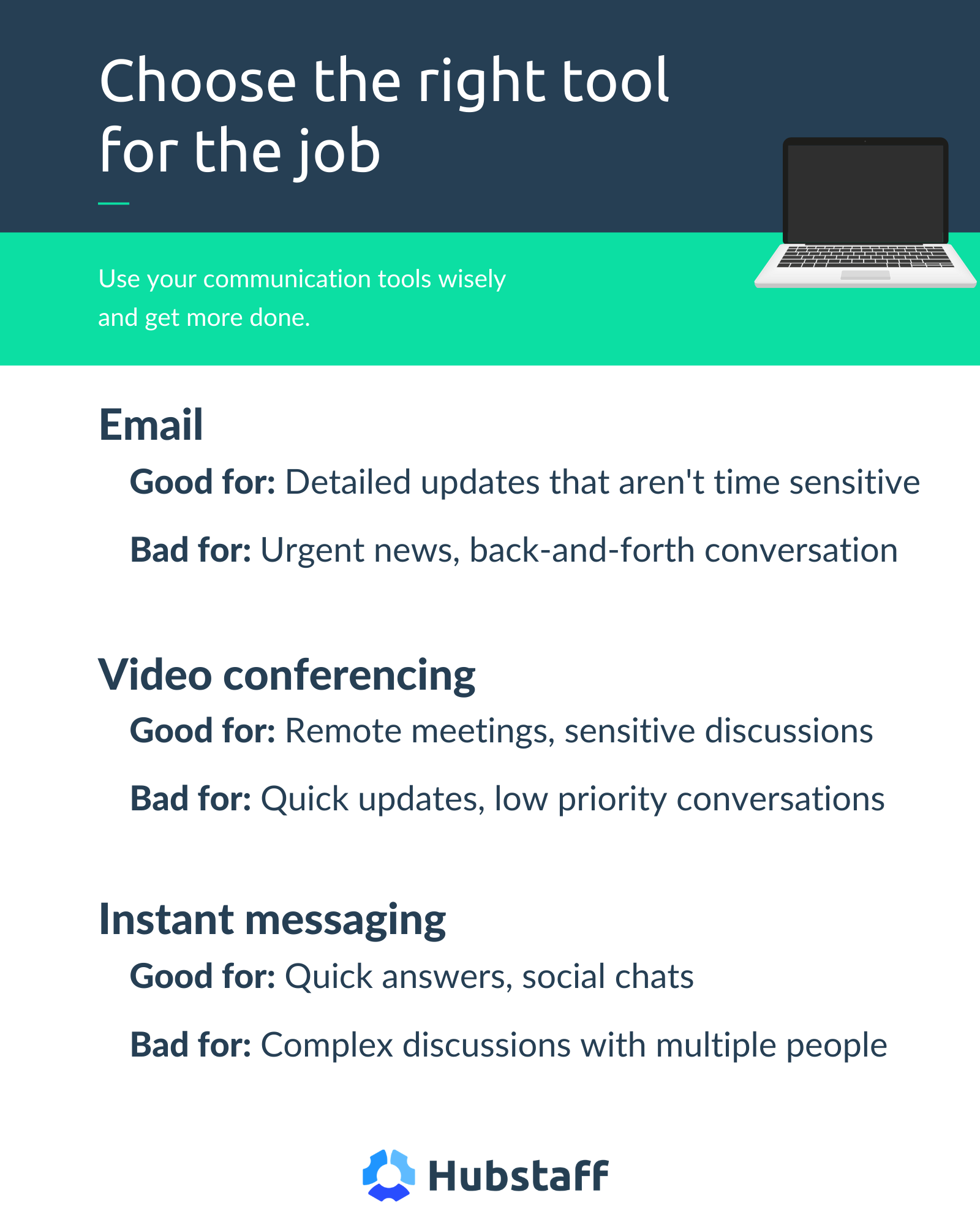
Create a communication policy
A communication policy serves to set expectations for team communication. It lets employees know how to communicate effectively.
The goal of having a communication policy is to help your team get better at sharing information. It should also stress the importance of communication for getting tasks and projects done on time consistently.
Any good communication policy should let employees know:
- When they’re expected to respond to messages
- What kind of communication is appropriate for each channel the team uses
- Whether they need to provide status updates (and how often)
- When and where meetings take place (and how they look like)
Want to see an example?
Download our Hubstaff Communication Manifesto for free and see how our team sets communication guidelines.
8. Provide feedback
According to one study, 82% of employees state that they actually appreciate receiving feedback.
However, 62% claim that their manager should provide higher-quality feedback. Here’s how to do that:
- Avoid generic comments – Just saying “Good job.” isn’t enough. Let the employee know what you liked and disliked about their performance specifically. Make your feedback specific and solution-oriented. Employees need to understand what the issue is and how they can improve. For example, let’s say you gave one of your employees the task of preparing a presentation for a client. Their presentation had all the right information but lacked compelling visuals. In this case, you should praise the employee for making sure that all the information in the presentation was accurate. But, you should also mention how the presentation would have been even more effective if it included some compelling graphics and ask them to remember to include them next time.
- Focus on performance and behavior – Avoid making comments regarding an employee’s personality. Focus on their behavior and performance. Give specific guidance on how they can improve both.
- Praise in public, criticize in private – Never criticize employees publicly. Provide feedback in private. You can also deliver feedback in writing (e.g., by sending the employee an email). Keep in mind that it’s better to provide negative feedback in person to avoid any misunderstandings.
- Provide feedback as soon as possible – It’s crucial to provide feedback as soon as possible. Don’t wait for a performance review to give feedback.
9. Have more effective meetings
Most meetings last between 30 to 60 minutes. Employees consider a third of each meeting to be completely unproductive.
If you have ineffective meetings, you’re wasting thousands of productive hours every year.
That’s 10 to 20 minutes of time spent per meeting. If you hold just two meetings every week, that’s 20 to 40 minutes wasted per week. During the course of a year, that adds up to between 1,000 and 2,000 hours. That’s a lot of time your employees could spend doing actual work.
Here’s how to have more effective and productive meetings:
Consider if you really need to hold a meeting – You can resolve a lot of issues over email or a quick Slack message. Don’t immediately schedule a meeting for every little issue.
Invite only those employees who need to attend – Most issues don’t require an all-hands meeting. Think hard about which employees absolutely need to attend the meeting.
Create a meeting agenda – If you want to have a productive meeting, creating an agenda is crucial. Write down talking points and end goals for each meeting.
Make it short – If you schedule a 60-minute meeting, you’ll find a way to fill up that time, even if you could have wrapped up the meeting sooner. Try to figure out how much time you really need to discuss the issue.
End with clear next steps – You should end each meeting by assigning action items to everyone involved. This will ensure your team takes action to solve the issue.
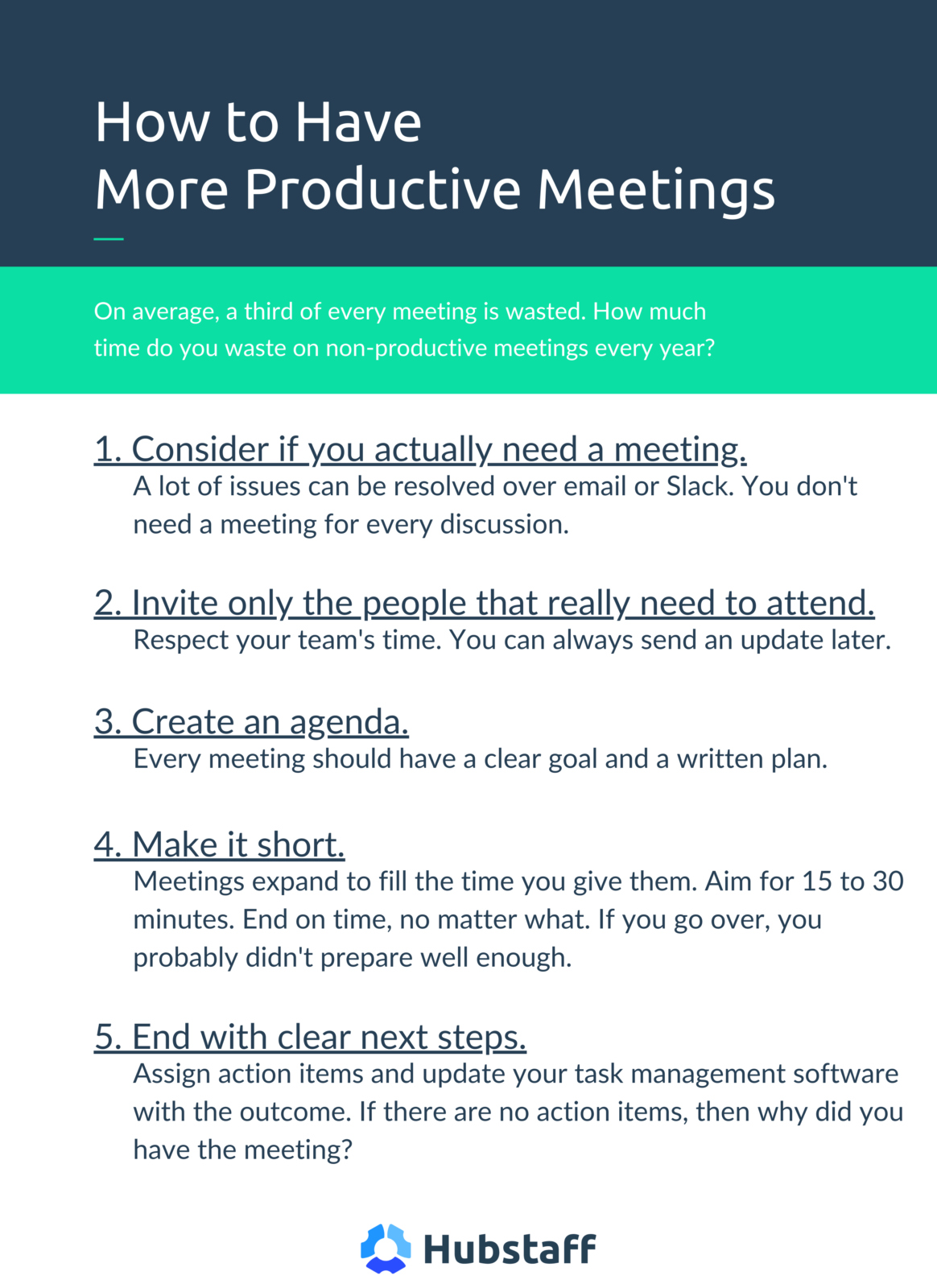
10. Let your team work a flexible schedule
A traditional 9-to-5 schedule doesn’t work for everyone. In fact, 47% of employees strongly agree that flexible schedules would allow them to be more productive.
Businesses have increasingly started to realize this in recent years. More and more companies let their employees work a flexible schedule.

This gives employees the opportunity to create a schedule that works for them. That way, they can work at times when they’re most productive instead of forcing themselves to work through regular work hours.
A flexible schedule makes your employees happier, boosting employee productivity even further.
Here’s how you can implement a flexible work schedule at your organization:
- Create a flexible schedule policy – Your policy should outline clear guidelines on attendance, availability, and communication. This will make sure employees don’t abuse your new flexible schedule arrangement.
- Do a phased roll-out – Start by implementing a flexible schedule for a single department. Closely monitor employee performance during this time. If all works out well, roll out a flexible schedule for your entire organization.
- Measure performance – It’s important to measure the effect of your new flexible schedule on employees’ productivity. Are you seeing tasks completed more quickly or projects moving forward faster? If so, you’re on the right track.
Get our free Work From Home Policy Template and get started on your own remote work policy.
11. Provide team members with the right tools
There are plenty of tools out there that can help your team members be more productive. However, you need to choose your tools carefully. Just because a solution works great for another team, it doesn’t mean that it will make your team more productive.
Test each tool before implementing it across your entire company. If you’re going to use a paid tool, make sure it can actually deliver a positive return on investment for your business.
Software solutions can help you simplify:
- Communication – Tools that aid and simplify communication are a necessity for modern teams. Consider using solutions such as Slack and Zoom to help team members communicate more effectively.
- Project management – A project management tool will allow team members to collaborate more effectively. Solutions like Hubstaff Tasks enable teams to collaborate on tasks in real-time using comments, mentions, and checklists.
- Process documentation – Documenting all your processes ensures team members know how to approach completing tasks correctly. You can use tools like Process Street to create process documentation for your team.
- File storage and document management – Your team needs a way to share files and collaborate on documents. This is where solutions like Dropbox and Google Drive can help.
Keep everything on track without lifting a finger
Manage almost everything from the Agile-friendly PM tool, Hubstaff Tasks. Sprints, Kanban workflows, Stand-ups, and so much more.
49+ of the Best Online Collaboration Tools for Productive Teams
12. Encourage deep work
It can take employees up to 23 minutes to focus after being interrupted.

That’s a decent chunk of time spent. Now think about how many times your employees get interrupted during the day.
Emails, phone calls, and team members popping by to ask a question are just a few different types of interruptions your employees likely deal with on a daily basis.
It takes about 23 minutes to refocus after being interrupted. Your “quick questions” eat up a lot more productive time than you think.
If employees could work the entire day without interruptions, their overall productivity would skyrocket. While it’s unrealistic to try to eliminate interruptions completely, there are some things you can do to reduce interruptions, such as:
- Letting team members use noise-canceling headphones – If your team works in an office, consider letting some or all team members use noise-canceling headphones during the workday. If your employees work from home, provide them with a pair of headphones they can use to focus more easily.
- Instructing them to turn off notifications when they really need to focus – Does your team use Slack? While a highly useful tool, it can also be very distracting. Instruct team members to turn off Slack notifications when they’re working on a task that requires their full attention.
Doing these things promotes deep work and helps team members get into a state of flow. When employees are in a state of flow, they’re highly focused on the task at hand, which helps increase their:
- Productivity – People have shown to be as much as five times more productive when in a state of flow.
- Creativity – Those working in flow state report being six to eight times more creative.
- Learning abilities – A number of studies show people learn up to 500% faster when in a state of flow.
- Subjective well-being and happiness – Being in a state of flow can also improve your employees’ subjective well-being and happiness.
13. Take care of your employees’ health
Your employees need to stay healthy, both physically and mentally, in order to be productive.
That’s why 70% of companies offer some form of employee wellness program.
53% of employees with access to company wellness programs state that these programs improve their health. According to employees, these programs help them:
- Pay more attention to their health
- Lose weight
- Detect and prevent diseases
They also help cut down on sick days and improve employee productivity.
If you want to encourage employees to stay healthy, start by paying more attention to them. Do they seem stressed out or tired? Do you think that some employees might be close to burning out?
Then, look into ways you can help them. Would a more generous time-off policy help employees keep their health in check? Similarly, do you think implementing a flexible work schedule could help your team achieve better work-life balance?
Put some thought into what you could do to help employees stay healthy. If you’re not sure, ask them. Your employees will certainly have multiple ideas of how the organization could help them take care of their health.
An added benefit of implementing ideas your employees suggest is that it increases the chances of them actually taking advantage of your wellness initiatives.
14. Streamline your team’s workflow
If you haven’t optimized your workflows lately, you probably have some inefficiencies and bottlenecks to fix. Addressing these is crucial for increasing employee productivity.

Think about the biggest workflow problems your team deals with on a regular basis. Start there and look for ways to improve or automate parts of your workflow.
Automation can be of big help when you’re looking to streamline your workflow. Thanks to technology, today’s businesses can automate 45% of employee activities, including:
- Appointment scheduling
- Lead generation
- Invoicing
- Payroll
- Social media marketing
- Website backup
Look for a project management tool that already has automation features built in. You don’t have to start from scratch.
Creating a Project Management Workflow and the Best Software to Help You
15. Make sure everyone’s on the same page
A lack of team efficiency often comes from team members not having access to all the information they need to do their job effectively.
If you’re the only one who knows all important information, you’re the only person in your company who can make good decisions. That’s not an efficient way to work.
To increase employee productivity, focus on improving transparency. This will help keep everyone on the same page and allow team members to do their best work.
Being transparent with employees builds trust. This, in turn, helps employees to commit to your company’s cause more easily. It also allows them to see the big picture and understand how their efforts are directly contributing to the company’s goals.
When employees work in a transparent environment, they feel more comfortable sharing their ideas. This helps the team productivity.
Here are some ways you can improve transparency and avoid creating information silos:
Record every meeting
There will always be meetings where one or more people who needed to attend were missing. It’s important that you provide a way for these people to review what the team discussed during the meeting.
Try to record or make a transcript of every meeting.
For video meetings, this is easy. Set the default settings to record to the cloud, then post the recording in a Slack channel or in your task software.
If you have your meetings face-to-face, use a simple recording program on your phone or laptop. Audio alone might be okay unless you’re whiteboarding an idea. In that case, you should also try to record video.
When those options aren’t practical, assign someone to take detailed meeting notes instead. Take pictures of any whiteboards and share the notes with all attendees.
Recording in-person meetings will take some trial and error, especially if you have some people dialed in on the phone and some in the room. Test a few solutions and find one that works best for your team.
Keep important discussions in public channels
You should have important discussions in a place where everyone can contribute. This doesn’t need to be an all-hands meeting.
A lot of modern teams, especially remote ones, use public Slack channels for important discussions.
Be mindful of interruptions when you use solutions like Slack for group discussions. Threaded comments can help you keep conversations organized, and it prevents notifications from bothering people who don’t need to be involved in the conversation.
Make sure you post in appropriate channels. You don’t need to have a discussion about bug fixes in the general channel. Create channels for departments or business groups for more specialized topics.
Create a single source of truth
A single source of truth (SSOT) is a database that contains all the information on your company’s workflows, processes, and projects. Having such a database ensures everyone on your team has access to all the information they might need.
When creating an SSOT, it’s important to get employee buy-in first. You can do this by explaining why creating such a database is important and how it can make their job easier.
If you want employees to keep contributing to the database, you should make it as easy as possible for them to do so. One way to do this is to use a dedicated tool like Confluence.
Finally, it’s important that you check and cleanse all the data that comes into your database to prevent any issues later.
Transparency and Ethics in Business: How to Make Them Work for You
Start improving employee productivity today
That’s enough reading for today. It’s time to take action.
Here’s what you need to do:
- Make a list of your biggest employee productivity challenges – What are the biggest issues stopping your employees from being more productive? Is it a lack of skills, poor communication, or something else? Write all of these down right now, while you still have this blog post open.
- Decide on your priorities – Look at your list and determine one or two challenges that should be the easiest to fix. Make these your priority.
- Let team members know – Send an email to your team members and let them know that you’re looking to solve these specific challenges. This will make sure everyone’s on the same page and ensure team members can actively contribute to solving employee productivity problems.
Finally, bookmark this post so you can come back to it.
Eager to learn more about improving employee productivity? Check out the following blog posts:
How to Keep Your Employees Focused and Productive – Learn more tips on how to help employees stay focused and improve employee productivity in the process.
8 Time Wasters at Work (and How to Nip Them in the Bud) – Find out some of the most common time-wasting activities at work and learn how to stop employees from engaging in them.
8 Best Online Work Timers to Accelerate Your Productivity – Read this blog post to learn about the best software solutions for improving employee productivity and reducing time spent on lesser tasks.
Subscribe to the Hubstaff blog for more posts like this
This post was originally published in February 2020. It was updated in January 2021.
Most popular
The Fundamentals of Employee Goal Setting
Employee goal setting is crucial for reaching broader business goals, but a lot of us struggle to know where to start. American...
Data-Driven Productivity with Hubstaff Insights: Webinar Recap
In our recent webinar, the product team provided a deep overview of the Hubstaff Insights add-on, a powerful productivity measurem...
The Critical Role of Employee Monitoring and Workplace Security
Why do we need employee monitoring and workplace security? Companies had to adapt fast when the world shifted to remote work...
15 Ways to Use AI in the Workforce
Whether through AI-powered project management, strategic planning, or simply automating simple admin work, we’ve seen a dramatic...



